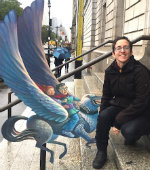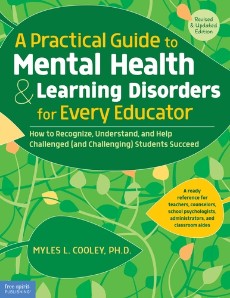Helping Students with Mental Challenges
A Practical Guide for Mental Health and Learning Disorders for Every Educator: How to Recognize, Understand and Help Challenged (and Challenging) Students Succeed, Revised and Updated
By Myles L. Cooley, PhD
(Free Spirit Publishing, 2018 – Learn more)

A Practical Guide for Mental Health and Learning Disorders for Every Educator by Myles L. Cooley, PhD offers something for both new and experienced teachers.
The book is an update of a previous 2007 edition. It starts with an important reminder that education is always changing and we must change as teachers (regardless the years of experience) to meet the needs of today’s students.

There are four pages of sample behavior contracts, a self-monitoring checklist and respectful behavior certificates. Personally, after many years of teaching, it is always my number one goal to promote respectful behavior among students.
School-wide impact
The book also takes a look at the bigger picture and that is school-wide rules. Many people have argued with me on this point, but I feel that behavior in the school starts with school-wide rules. I have received beginning-of-the-year handouts where it clearly stated not to call the office for difficult behavior in the classroom. So it’s not surprising when some teachers don’t want to reach out to school administrators and other school personnel for help.
ASK FOR HELP if you need it and follow-up until you get it. This helps both you and the child.
Achieving cultural awareness
Chapter 4 was of special interest to me because I teach in a very culturally diverse area (Queens, New York). There are four strategies offered for fostering cultural awareness in your classroom. Many teachers promote activities at the start of the school year that focus of these strategies. The first one is to inquire about your student’s background. The second one is to ask students what interests them.
The third one and most important is to be sensitive to language differences. I also find it upsetting when I cannot understand students, whether they are ESL or Special Education. The student can often pick up on this, and it is frustrating for both teacher and student.
Teachers sometimes don’t have total control over curriculum, but the book encourages a curriculum that recognizes many cultures. Many schools also offer a Thanksgiving sharing night or a Multicultural Night of music and dance to celebrate and allow students and adults to get to know different cultures.
The fourth strategy is a reminder that the teacher always needs to have high expectations. Students will work harder when the expectations are higher. The chapter offers a classroom and curriculum checklist that all teachers can review to make their classrooms more culturally diverse.
Focusing on specific disorders
A major part of this book focuses on mental health and learning disorders. Chapter 7 starts with, “I’m a normal person whose mind may be a little abnormal, but my mental health problems aren’t me. They don’t define me. They are part of me but they aren’t my identity.” (Sophie Dishman, twenty-two-year-old with obsessive-compulsive disorder and anxiety).
This quote reminds me of the book (Don’t) Call Me Crazy. 33 Voices Start the Conversation About Mental Health edited by Kelly Jensen where this is clearly stated. Many stories in (Don’t) Call Me Crazy could be shared one on one with a student or whole class. They are geared toward upper middle school or high school.
The core chapters in Dr. Cooley’s book each deal with a specific disorder and have a lot of useful information. Here I am going to focus on Chapter 13, Disruptive and Conduct Disorders. These disorders are Oppositional Defiant Disorder (ODD) and Conduct Disorder (CD).
A mental health professional is always needed to make a diagnosis about a child. However, the chapter shares behaviors and symptoms to look for in ODD students which includes losing their temper, arguing with adults, refusing to follow rules, deliberately annoying others, blaming others for mistakes, getting easily annoyed by others, being angry and resentful, and being spiteful and vindictive.
I think some of Chapter 13’s strategies and interventions are very positive. One strategy is to build a strong relationship with the child. When a child can build a strong relationship with the teacher, it can sometimes be calming for them. I was also happy to see Dr. Cooley mention that it’s important to address students’ behavior with the help of administrators, counselors and other school staff.
For teachers who are planning professional development this year, the publisher offers a free online guide. This is a great way to start a staff conversation about mental health and students. Every student deserves to receive the help they need. As a teacher you can start that conversation!
Elizabeth OBrien has worked for the Department of Education in New York City in many different teaching roles. Her main desire as an educator has been to allow children to explore and discover by giving them the right guiding tools. Her favorite quote from Albert Einstein is “The true sign of intelligence is not knowledge but imagination.”






























